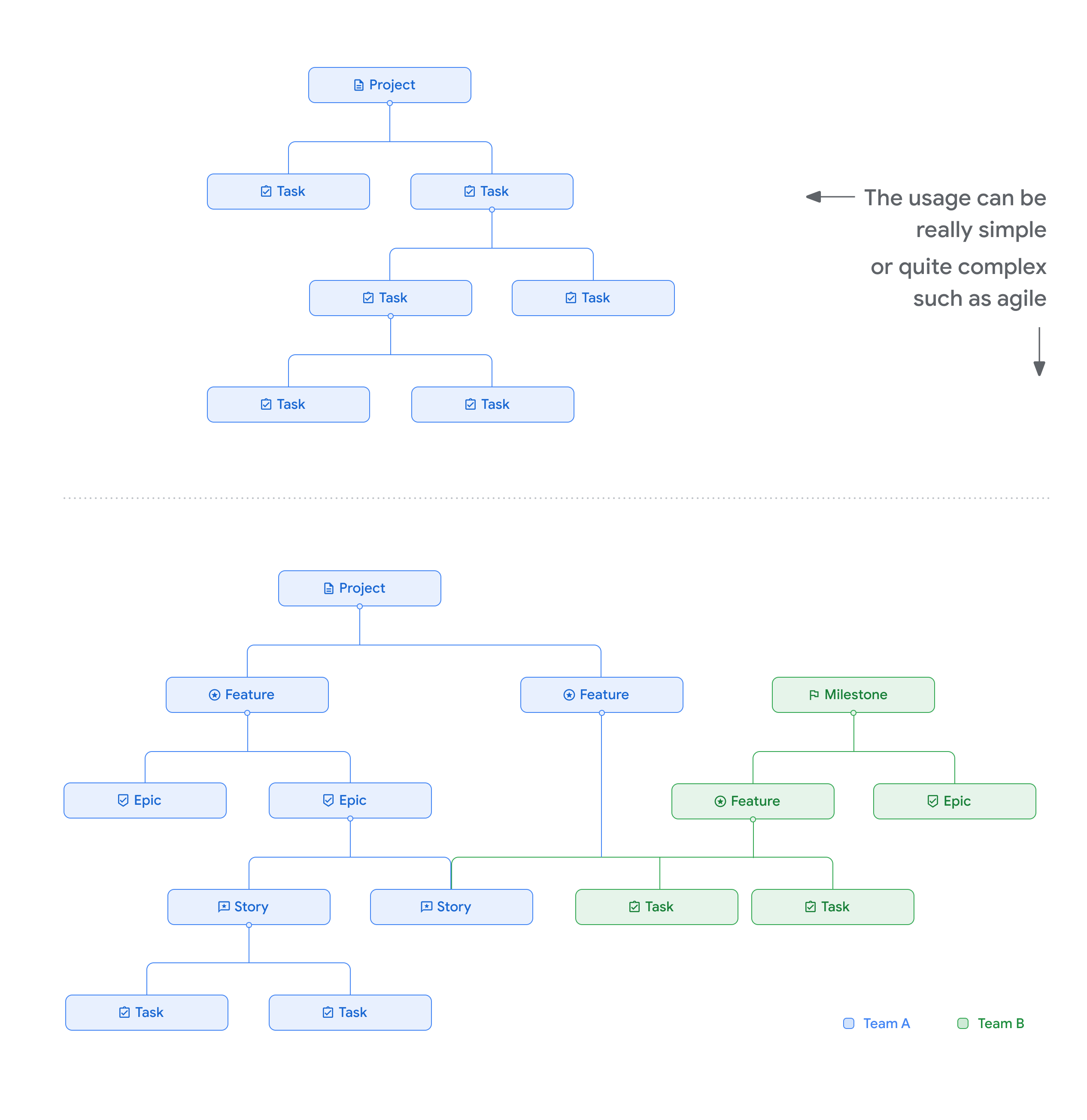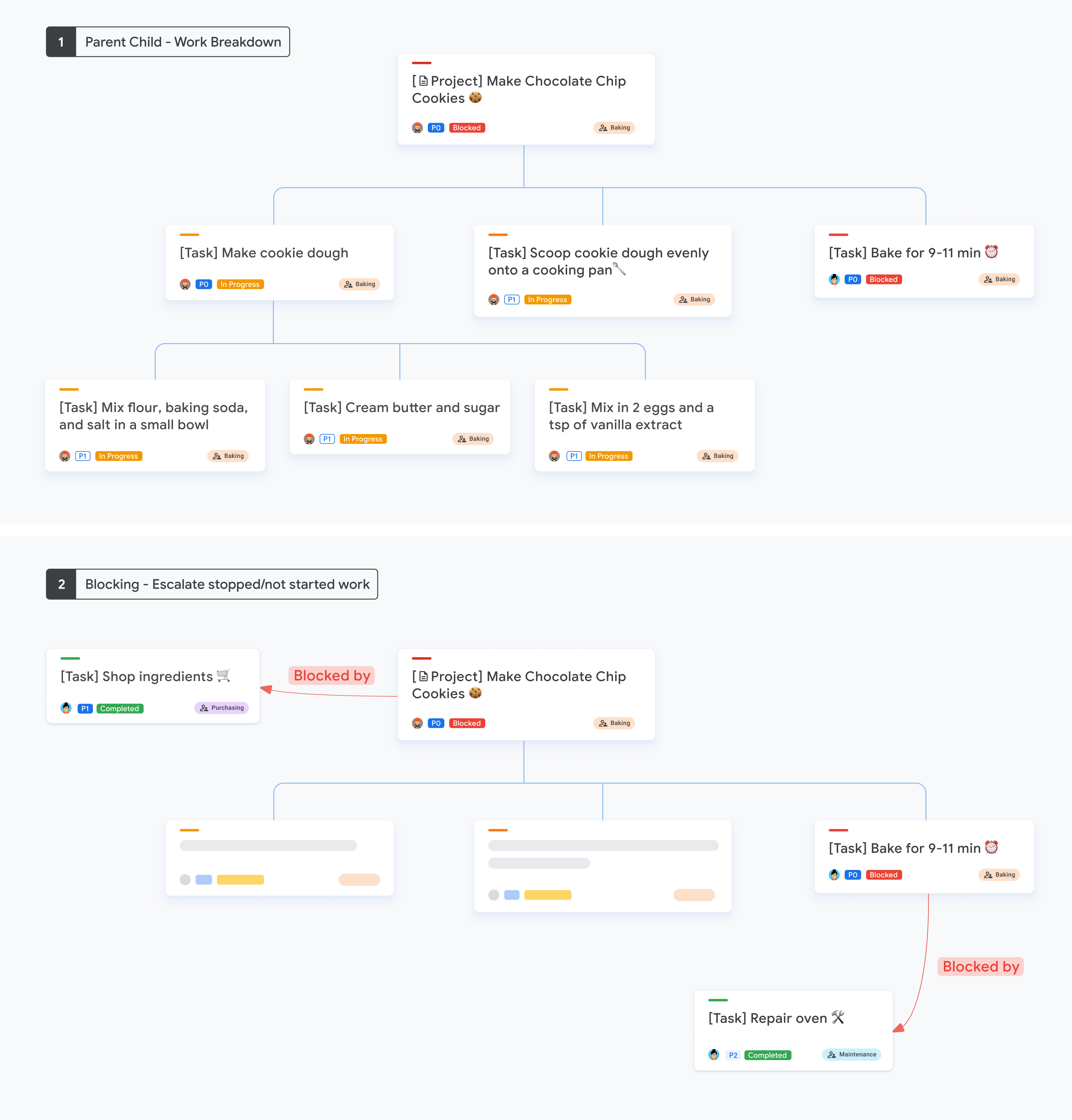علاقات الآباء والأمهات والأطفال
تنظيم صفحاتك في مجموعات
يمكنك حفظ المحتوى وتصنيفه حسب إعداداتك المفضّلة.
يتيح "نظام تتبُّع المشاكل" من Google العلاقات بين الوالدَين والطفل. يتم استخدام علاقة "العنصر الرئيسي والعنصر الفرعي" عادةً لتمثيل تقسيم العمل ضمن جهد معيّن. يمكن أن يكون لدى أحد الوالدَين عدة أطفال، ويمكن أن يكون لدى الطفل عدة
والدَين.
تتسم العلاقة بين العنصر الرئيسي والعنصر الثانوي بالخصائص التالية:
| سمة |
التفاصيل |
| العلاقة |
N:N |
| طلب المحتوى |
يمكن ترتيب الملفات الشخصية للأطفال ضمن حساب أحد الوالدَين. |
| رصد الأنشطة الرياضية |
يمنع النظام التبعيات الدائرية. |
| الحد الأقصى لعدد العناصر المباشرة الفرعية |
500 |
| الحد الأقصى لعدد الأسلاف |
1000 |
أمثلة
يعرض الرسم البياني التالي بعض نماذج العلاقات بين العناصر الرئيسية والعناصر الفرعية.

العلاقات بين الوالدَين والطفل والحظر
لا تزال العلاقات الحالية حظر وتم حظره من قِبل متاحة عند استخدام العلاقات بين الوالدَين والطفل. عند الجمع بين علاقات والدَي الطفل
وعمليات الحظر:
- استخدِم العلاقات الرئيسية-الفرعية لتقسيم العمل إلى وحدات أصغر.
- استخدِم حظر وتم حظره من قِبل عندما يكون التوقيت والتسلسل مهمّين،
وتريد تقديم إشارات واضحة في واجهة المستخدم لتصعيد العمل الذي توقّف أو
لم يبدأ.
يعرض الرسم البياني التالي أمثلة على تقسيمات العمل
بين العناصر الرئيسية والعناصر الفرعية وعمليات الحظر.

جميع الحقوق محفوظة. إنّ Java علامة تجارية مسجَّلة لشركة Oracle و/أو شركائها التابعين.
تاريخ التعديل الأخير: 2025-07-25 (حسب التوقيت العالمي المتفَّق عليه)
[null,null,["تاريخ التعديل الأخير: 2025-07-25 (حسب التوقيت العالمي المتفَّق عليه)"],[[["\u003cp\u003eGoogle Issue Tracker enables the creation of parent-child relationships to represent the hierarchical breakdown of work within a project.\u003c/p\u003e\n"],["\u003cp\u003eIssues can have multiple parents and children, but the system prevents circular dependencies and limits the number of direct children to 500 and total ancestors to 1000.\u003c/p\u003e\n"],["\u003cp\u003eWhile parent-child relationships are ideal for structuring tasks, "Blocking" and "Blocked by" relationships should be used to indicate critical timing and sequencing dependencies.\u003c/p\u003e\n"],["\u003cp\u003eUsers are encouraged to leverage both relationship types to manage work effectively, using parent-child for work breakdown and blocking for highlighting time-sensitive dependencies.\u003c/p\u003e\n"]]],[],null,["# Parent-Child Relationships\n\nGoogle Issue Tracker supports parent-child relationships. A parent-child\nrelationship is typically used to represent the breakdown of work within a given\neffort. A parent can have multiple children, and a child can have multiple\nparents.\n\nThe parent-child relationship has the following characteristics:\n\n| Characteristic | Details |\n|-------------------------|----------------------------------------------------|\n| **Relationship** | N:N |\n| **Ordering** | Ordering of children within a parent is supported. |\n| **Cycle detection** | Cyclic dependencies are prevented by the system. |\n| **Max direct children** | 500 |\n| **Max ancestors** | 1000 |\n\nExamples\n--------\n\nThe following graphic shows some sample parent-child relationships.\n\nParent-child relationships and blocking\n---------------------------------------\n\nThe existing **Blocking** and **Blocked by** relationships are still supported\nwhen you use parent-child relationships. When you're combining parent-child\nrelationships with blocking:\n\n- Use **parent-child** relationships to break down work into smaller units.\n- Use **blocking** and **blocked by** when timing and sequence are critical, and you want to provide clear indications in the UI to escalate stopped or not started work.\n\nThe following graphic shows examples of parent-child and blocking work\nbreakdowns."]]
![]()
![]()
